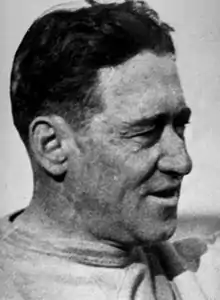Frank Cavanaugh (American football)
Francis "Frank" William Cavanaugh (April 28, 1876 – August 29, 1933) was an American college football player and coach. Nicknamed "Cav" and "The Iron Major," Cavanaugh was inducted into the College Football Hall of Fame as a coach in 1954.
 Cavanaugh in circa 1930. | |
| Biographical details | |
|---|---|
| Born | April 28, 1876 Worcester, Massachusetts, United States |
| Died | August 29, 1933 (aged 57) Marshfield, Massachusetts, United States |
| Playing career | |
| 1896–1897 | Dartmouth |
| Position(s) | End |
| Coaching career (HC unless noted) | |
| 1898 | Cincinnati |
| 1898–1902 | Denver Athletic Club |
| 1903–1905 | Holy Cross |
| 1909–1910 | Worcester Academy |
| 1911–1916 | Dartmouth |
| 1919–1926 | Boston College |
| 1927–1932 | Fordham |
| Head coaching record | |
| Overall | 145–48–17 (college) |
| College Football Hall of Fame Inducted in 1954 (profile) | |
Career
Born in Worcester, Cavanaugh played college football as an end at Dartmouth College from 1896 to 1897, under coach William Wurtenburg.
Cavanaugh served as the head football coach at the University of Cincinnati (1898), and then followed with a stint coaching at the Denver Athletic Club (1898-1903). He would return to his native Worcester to coach at the College of the Holy Cross (1903–1905), followed by high school coaching at Worcester Academy (1909-1910).
Cavanaugh left Worcester to return to college football with Dartmouth College (1911–1916). There, he would coach Lawrence Whitney, who also attended Worcester Academy at the same time Cavanaugh coached there. He left Dartmouth to enter the United States Army to serve during World War I in 1917. He rose to the rank of major, but was seriously wounded during the Meuse–Argonne Offensive on October 23, 1918. Shellfire broke his cheek, nose, and skull, all of which contributed to later blindness.
In 1919, Cavanaugh published a book about football titled Inside Football.[1]
Cavanaugh's final two coaching stints were at Boston College (1919–1926) and Fordham University (1927–1932), respectively. At Fordham, he implemented the T formation on offense. He ultimately compiled a career coaching record of 148–50–18.
At the time of his death in 1933, Cavanaugh was bankrupt. He was survived by his widow, Florence Ayres, and their seven children.[2]
On October 25, 1943, a biographical film about Cavanaugh's life was released by RKO Pictures titled The Iron Major, based on his wife's recounts. The actor Pat O'Brien would play the main role.
In 1954, Cavanaugh was posthumously inducted into the College Football Hall of Fame as a coach.
Coaching tree
Cavanaugh played under one college football head coach:
- William Wurtenburg, Dartmouth (1896-1897)
Five of Cavanaugh's assistant coaches, who were also his former players, became college football head coaches:
- Tony Comerford, Loyola (1928-1933)
- Jogger Elcock, Washington and Lee (1914-1916), Oglethorpe (1920-1921)
- Wesley Englehorn, Case Western (1914-1916), Amherst (1921)
- Dinny McNamara, Boston College (1935)
- Dave Morey, Middlebury (1921-1924), Auburn (1925-1927), Bates (1929-1939)
Three of Cavanaugh's assistant coaches became college football head coaches:
- William Coady, Boston College (1921-1925)
- Frederick E. Jennings, Dartmouth (1900)
- William Joy, Boston College (1912-1913), Canisius (1933-1938)
Three of Cavanaugh's former players became college football head coaches:
- John B. McAuliffe, Marquette (1916), Colby (1920-1921), Catholic (1925-1929)
- Joe McKenney, Boston College (1928-1934)
- Luke Urban, Canisius (1921-1930)
Head coaching record
| Year | Team | Overall | Conference | Standing | Bowl/playoffs | ||||
|---|---|---|---|---|---|---|---|---|---|
| Cincinnati (Independent) (1898) | |||||||||
| 1898 | Cincinnati | 5–1–3 | |||||||
| Cincinnati: | 5–1–3 | ||||||||
| Holy Cross (Independent) (1903–1905) | |||||||||
| 1903 | Holy Cross | 8–2 | |||||||
| 1904 | Holy Cross | 2–5–2 | |||||||
| 1905 | Holy Cross | 6–3 | |||||||
| Holy Cross: | 16–10–2 | ||||||||
| Dartmouth (Independent) (1911–1916) | |||||||||
| 1911 | Dartmouth | 8–2 | |||||||
| 1912 | Dartmouth | 7–2 | |||||||
| 1913 | Dartmouth | 7–1 | |||||||
| 1914 | Dartmouth | 8–1 | |||||||
| 1915 | Dartmouth | 7–1–1 | |||||||
| 1916 | Dartmouth | 5–2–2 | |||||||
| Dartmouth: | 42–9–3 | ||||||||
| Boston College Eagles (Independent) (1919–1926) | |||||||||
| 1919 | Boston College | 5–3 | |||||||
| 1920 | Boston College | 8–0 | |||||||
| 1921 | Boston College | 4–3–1 | |||||||
| 1922 | Boston College | 6–2–1 | |||||||
| 1923 | Boston College | 7–1–1 | |||||||
| 1924 | Boston College | 6–3 | |||||||
| 1925 | Boston College | 6–2 | |||||||
| 1926 | Boston College | 6–0–2 | |||||||
| Boston College: | 48–14–5 | ||||||||
| Fordham Rams (Independent) (1927–1932) | |||||||||
| 1927 | Fordham | 3–5 | |||||||
| 1928 | Fordham | 4–5 | |||||||
| 1929 | Fordham | 7–0–2 | |||||||
| 1930 | Fordham | 8–1 | |||||||
| 1931 | Fordham | 6–1–2 | |||||||
| 1932 | Fordham | 6–2 | |||||||
| Fordham: | 34–14–4 | ||||||||
| Total: | 145–48–17 | ||||||||
References
- https://archive.org/details/insidefootball00cavagoog
- Murpky, Frank (1933-08-30). "Death Claims Major Frank Cavanaugh After Lingering Illness". the Waterbury Democrat. Retrieved 4 November 2021.